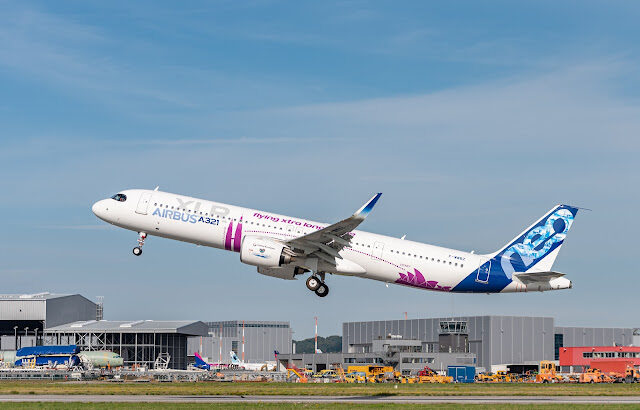This month Airbus commenced a series of long duration test flights as part of the certification process for the Airbus A321XLR. Two of the three aircraft in the certificate programme operated test flights through Irish airspace.
The first aircraft F-WWAB Airbus A321-253NY msn 11080 callsign ‘AIB03AB’ passed overhead Dublin on 7-8th December on an 9 hour 20 minute flights.
The second aircraft F-WXLR Airbus A321-251NY msn 11000 callsign ‘AIBXLR’ on 13th December drew considerable attention in the aviation community and media as the aircraft flew over the Bay of Biscay and drew a 500 km wide, 150 km tall “XLR” in the sky at Flight Level FL270 (27,000ft).
The aircraft routed overhead County Wexford up the east coast over Dublin, Ireland and over the towns of Newcastle and Newtownards, County Down , Northern Ireland between 1253-1315 local at Flight Level FL390 (39,000ft).
The current timeline suggests that entry into service with Middle East Airlines is now likely to be 2024Q2, according to Airbus.
In June 2019 Airbus formally launched the A321XLR to complement its best-selling A321neo Family, in response to the market. The aircraft will deliver an unprecedented single-aisle aircraft range of up to up to 4,700nm (8700 km) 15% more than the existing A321LR platform with 30% lower fuel consumption per seat compared to previous-generation aircraft.
The Airbus A321XLR is estimated to cost $142 million at 2018 list prices.
The International Airlines Group (IAG) ordered six Airbus A321XLRs for Aer Lingus with a further eight options with the carrier being a launch customer. IAG stated “These aircraft will enable Aer Lingus to launch new routes beyond the US East Coast and Canada.”
Former International Airlines Group (IAG) CEO Willie Walsh stated “The A321XLR has the same unit cost as a widebody long haul aircraft which will enable profitable network expansion. This will strengthen both Dublin and Madrid hubs providing new transatlantic routes and additional flexibility for connecting passengers. These aircraft will also bring further cost efficiencies and environmental benefits.”
Image Credit: Airbus
Why The Airbus A321XLR Will Change The Way We Fly
Irish Aviation Research Institute © 29 December 2022 All Rights Reserved


